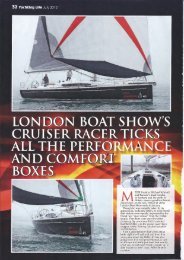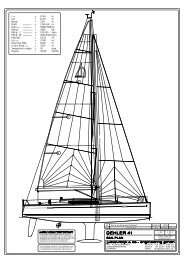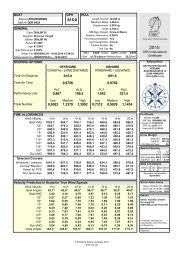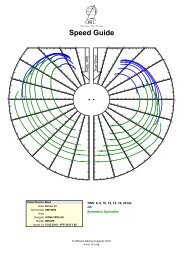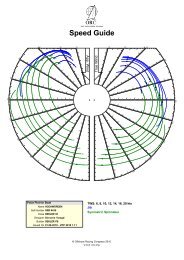You also want an ePaper? Increase the reach of your titles
YUMPU automatically turns print PDFs into web optimized ePapers that Google loves.
sail Test<br />
DEHLER 29<br />
72 tradeaboat.com.au<br />
STORY & PHOTOS ALLAN WHITING<br />
baby bonus<br />
Many sailors want a yacht that’s big enough to daysail<br />
with friends, easy enough for two or three people to race<br />
and cheap to berth. They need look no farther than the<br />
entry-level <strong>Dehler</strong> 29<br />
tradeaboat.com.au 73
sailTest<br />
Although a new arrival<br />
Down Under the <strong>Dehler</strong><br />
29 has been around for a<br />
few years — long enough<br />
to have won Europe’s<br />
Boat of the Year Award in 1997 and<br />
Cruising World Magazine’s Boat of<br />
the Year Award in 1999. Back then<br />
the slippery shape sported a Bavarialook<br />
cabin top, but now the boat<br />
has a redesigned ‘family look’ coach<br />
house profile. The current upsweptport<br />
cabin top makes the <strong>Dehler</strong> 29<br />
fit with newer models in the range.<br />
Although the hull shape is<br />
substantially unchanged the new<br />
interior is a welcome move away<br />
from the original’s heavy-looking<br />
furniture layout, with its prominent,<br />
quirky round sink and pedestal.<br />
The new design is understated and<br />
makes the saloon look much larger<br />
and airier than you’d expect in a<br />
29-footer.<br />
The impression of space is<br />
heightened by the fact that the<br />
forward vee-berth is undisguised:<br />
clearly visible behind an open<br />
forward bulkhead. If you were<br />
entertaining a mob at anchor, the<br />
kids could easily pile into the veeberth<br />
area. The open bulkhead<br />
allows unrestricted space forward,<br />
so it would be easy to launch and<br />
retrieve sails through the forward<br />
hatch.<br />
Space utilisation has been planned<br />
carefully inside the latest <strong>Dehler</strong> 29’s<br />
monolithic hull. There’s almost no<br />
bilge, other than shallow depressions<br />
under the saloon’s lift-up floor panels,<br />
so the cabin sole in the galley, head<br />
and aft cabin is actually the upper<br />
surface of the hull laminate. This<br />
design maximises headroom in these<br />
walking areas.<br />
Because the <strong>Dehler</strong> 29 interior<br />
is open-plan the designers, Judel<br />
and Vrolijk, adopted a different<br />
method of transferring rig and<br />
keel loads throughout the hull and<br />
deck structure. A ladder sub-frame<br />
bonds to the hull at the keel and<br />
compression-post-step attachment<br />
points and extends outwards to bond<br />
with a pair of massive stringers that<br />
run fore and aft behind the saloon<br />
furniture. Rig loads, via cap shrouds<br />
and lowers, are fed into these<br />
stringers, with turnbuckle links<br />
between the deck chainplates and<br />
the stringers. This load-path design<br />
allows for inboard chainplates,<br />
providing room for overlapping<br />
headsails to curve around the<br />
shrouds and spreaders.<br />
The original <strong>Dehler</strong> 29 sported a<br />
novel deck moulding adjacent to the<br />
cockpit coamings and that has been<br />
preserved on the revised boat. The<br />
deck level in this area is raised, aft of<br />
a bevelled cutwater and the design<br />
seems to fulfil a double function:<br />
Overall the <strong>Dehler</strong> 29 features equipment<br />
spec slightly higher than is normal on<br />
29ft boat. No complaints here.<br />
slightly improving headroom in<br />
the aft cabin and breaking water<br />
flow down the sidedecks. The<br />
latter feature promises to keep the<br />
helmsperson’s and sheet hand’s<br />
bottoms dry when they’re hiking<br />
over the cockpit coamings. The edge<br />
of this raised section is fitted with a<br />
teak toerail that aids foot grip when<br />
crew need to leave the cockpit and<br />
go forward.<br />
NO SHORTCUTS<br />
It’s common to find obvious costcutting<br />
in a 29-footer, but the <strong>Dehler</strong><br />
29’s construction and equipment<br />
levels are impressive. Monolithic,<br />
handlaid hull and balsa-cored deck<br />
are laminated together in the mould<br />
and internal deck reinforcement<br />
panels are bonded-in aluminium.<br />
Ten keel bolts penetrate two broad<br />
It’s common to find obvious costcutting<br />
in a 29-footer, but the <strong>Dehler</strong><br />
29’s construction and equipment<br />
levels are impressive<br />
backing plates, to secure the iron/<br />
lead keel.<br />
We crawled around the <strong>Dehler</strong><br />
29’s innards looking for some untidy<br />
corners, but couldn’t find any — fit<br />
and finish is exemplary for this size<br />
of boat.<br />
The 9/10th rig is Selden and<br />
includes a rod vang, oversized<br />
tackle-adjustable backstay, Dyneema<br />
halyards and a jib furler. A tackle<br />
mainsheet with ample purchase runs<br />
from a cockpit pedestal or optional<br />
traveller. Wire and chainplates<br />
wouldn’t look underdone on a<br />
35-footer and sails are North triradial-cut<br />
of heavier cloth than<br />
typical small-yacht kit.<br />
Below decks the saloon and cabins<br />
are spacious and well finished, and<br />
the galley comes with a large, deep<br />
sink and two-burner gimballed stove<br />
and oven. Standard in the generous<br />
head is a wet locker with door.<br />
What the <strong>Dehler</strong> 29 lacks in bilge<br />
storage space it makes up for in<br />
other areas. The saloon cupboards<br />
are huge, there’s wine storage<br />
in the centre of the drop-side<br />
While simplistic the interior is cleanly<br />
finished and fairly spacious thanks to the<br />
open door-less layout.<br />
dining table and the starboardside<br />
cockpit locker is the size of many<br />
40-footers’ lazarettes. Because the<br />
fuel tank won’t fit under-floor it’s<br />
located in this locker; being made<br />
of translucent plastic makes it easy<br />
to check the level of the contents<br />
without the need for a gauge.<br />
Engine and saildrive positioning<br />
optimises ease of access, with the<br />
engine located behind the leg. The<br />
companionway lifts away entirely,<br />
74 tradeaboat.com.au<br />
tradeaboat.com.au 75
sailTest<br />
[HIGHS]<br />
› Top-shelf mast and rig<br />
› Airy, spacious cabin and saloon<br />
› Quality fit and finish<br />
› Easy sail handling<br />
› <strong>Dehler</strong> companionway hatch<br />
system<br />
[LOWS]<br />
› Rudder shake under power<br />
Facts& figures<br />
DEHLER 29<br />
PRICE AS TESTED<br />
$154,613<br />
OPTIONS FITTED<br />
North ACL T-cut sails, Cruising Pack<br />
$7681 (additional AGM battery, Volvo<br />
Penta D1-20 saildrive, two-blade folding<br />
propeller, 12V fridge, 230V shorepower<br />
and battery charger), Harken<br />
mainsheet traveller, H&C cockpit<br />
shower, and iron/lead race keel<br />
PRICED FROM<br />
$137,500<br />
exposing the leg and rear of the<br />
engine, while the engine front is<br />
reached through lift-out panels in the<br />
aft cabin and head. Extensive noise<br />
and heat insulation keeps engine<br />
noise to a very low level.<br />
PERFORMANCE &<br />
HANDLING<br />
Our test sail was done in typical<br />
Sydney autumn fickle weather<br />
conditions, but we had a brief<br />
window of 5 to 6kts of sou’westerly<br />
to check the boat’s light-air<br />
capabilities. Considering the heavy<br />
sail cloth and small headsail fitted to<br />
the test boat it did remarkably well<br />
to ghost along at three-plus-knots in<br />
these light conditions. An overseas<br />
colleague vouched for the <strong>Dehler</strong> 29’s<br />
heavy-weather tolerance after he did<br />
a test in 20-knot conditions and came<br />
away impressed with its stability<br />
and ease of one-line reefing.<br />
The tiller and rudder combination<br />
is ideal for club racing, with<br />
very light action and an optional<br />
tiller extension making steering<br />
and hiking quite comfortable. If<br />
anything the tiller is a tad long<br />
and we’d probably slice off a<br />
few centimetres, to allow more<br />
clearance between the tip of the tiller<br />
and the mainsheet falls.<br />
Neutral rudder action is designed<br />
for sailing, without any weight bias<br />
in the rudder blade, so the tiller<br />
tended to wobble somewhat when<br />
under motor. We’d gladly put up with<br />
that rudder shake under power, in<br />
exchange for its superb feel when<br />
sailing.<br />
Multi-purchase mainsheets can<br />
be a literal pain, but the <strong>Dehler</strong> 29’s<br />
arrangement has easily-handled<br />
line that’s sheeted at around threequarter<br />
boom length. End-boom<br />
sheeting is more precise, but results<br />
in lots of mainsheet lying around the<br />
cockpit. With its powerful vang the<br />
<strong>Dehler</strong> 29 should be quite easy to<br />
handle in a blow with this layout.<br />
An optional Harken mainsheet<br />
traveller fits across the cockpit,<br />
forming a partition between the<br />
helmsperson/mainsheet hand and<br />
the headsail trimmer. The long tiller<br />
lifts out of the way when going<br />
Clever thinking has located the engine aft<br />
of the leg (above right) which maximises<br />
the otherwise tight servicing space.<br />
Shorthanded club racers should be<br />
pleased (below).<br />
[ SAYS… ]<br />
The <strong>Dehler</strong> brand is synonymous with performance and the<br />
29 shouldn’t disappoint. It’s a well-made boat with quality<br />
equipment, fit and finish not normally seen in such a small<br />
package. It can club race and cruise four-up, and below decks<br />
has plenty of party space.<br />
GENERAL<br />
MATERIAL: Polyester balsa sandwich<br />
deck; solid laminate hull<br />
TYPE: Keelboat<br />
LENGTH OVERALL: 8.75m<br />
WATERLINE LENGTH: 8m<br />
BEAM: 2.99m<br />
DRAFT: 1.58m (1.22m and 1.8m optional)<br />
WEIGHT: 2850 to 3150kg<br />
CAPACITIES<br />
BERTHS: Two doubles<br />
FUEL: 61lt<br />
WATER: 100lt<br />
SAILS<br />
MAINSAIL: 26m²<br />
HEADSAIL: 17m²<br />
GENOA: 25m² (optional)<br />
ENGINE<br />
MAKE/MODEL: Volvo Penta D1-13 (D1-<br />
20 optional)<br />
TYPE: Saildrive<br />
RATED HP: 12 (18 optional)<br />
PROP: Fixed two-blade (folding twoblade<br />
optional)<br />
about, so tacking duels shouldn’t be<br />
hard work. Standard is a pedestal<br />
mainsheet anchor point that would<br />
be less intrusive on cockpit space for<br />
a pure cruising yacht.<br />
Long deck sail tracks, shortish<br />
spreaders and inboard shrouds allow<br />
a varied sail plan, with an optional<br />
offering being a 120 per cent genoa<br />
in addition to the standard 105 per<br />
cent jib. An open-front pulpit should<br />
allow easy spinnaker pole handling.<br />
Dacron is the European standard<br />
sailcloth, but the local agent Team<br />
Windcraft prefers to see Australian<br />
<strong>Dehler</strong>s kitted with North tri-radial<br />
sails.<br />
In short, the <strong>Dehler</strong> 29 shares the<br />
high rig and equipment standards<br />
set by her larger siblings and has<br />
maximised below-deck living<br />
space. She is a budget-priced new<br />
yacht that offers ease of handling<br />
and good club racing potential for<br />
small crews.<br />
SUPPLIED BY<br />
Team Windcraft,<br />
Bayview Anchorage Marina,<br />
1714 Pittwater Road,<br />
Bayview, NSW, 2104<br />
Phone: (02) 9979 1709<br />
Fax: (02) 9979 2027<br />
Email: boats@windcraft.com.au<br />
Website: www.windcraft.com.au<br />
LAYOUT<br />
76 tradeaboat.com.au<br />
tradeaboat.com.au 77



